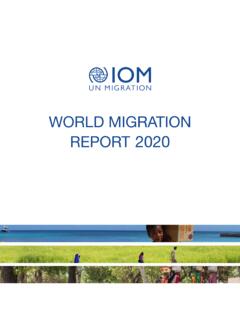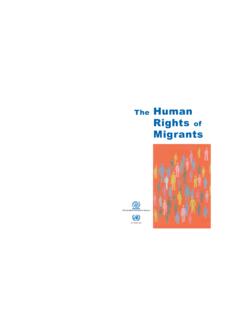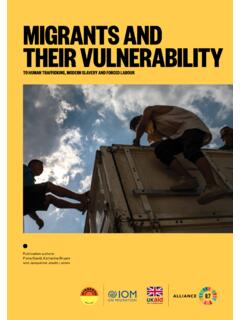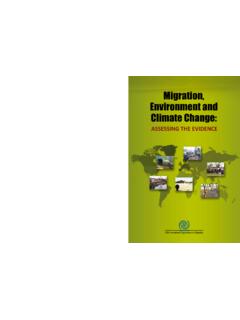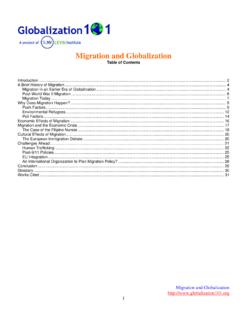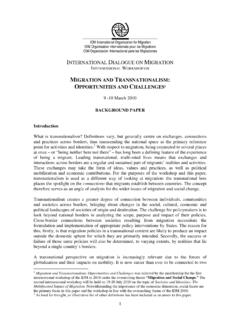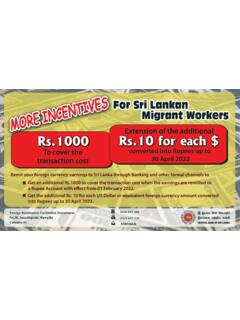Transcription of MIGRATION IN THE 2030 AGENDA - IOM Online Bookstore
1 MIGRATIONIN THE2030 AGENDAI nternational Organization for MigrationThe UN MIGRATION AgencyThe opinions expressed in the publication are those of the authors and do not necessarily reflect the views of the International Organization for MIGRATION (IOM) or the United States of America as the donor of the project, under which this publication is prepared. The designations employed and the presentation of material throughout the publication do not imply the expression of any opinion whatsoever on the part of IOM or the United States of America concerning the legal status of any country, territory, city or area, or of its authorities, or concerning its frontiers or is committed to the principle that humane and orderly MIGRATION benefits migrants and society. As an intergovernmental organization, IOM acts with its partners in the international community to: assist in meeting the operational challenges of MIGRATION ; advance understanding of MIGRATION issues; encourage social and economic development through MIGRATION ; and uphold the human dignity and well-being of : International Organization for MIGRATION 17 route des Morillons Box 17 1211 Geneva 19 Switzerland Tel.
2 : +41 22 717 91 11 Fax: +41 22 798 61 50 E-mail: Website: 2017 International Organization for MIGRATION (IOM)All rights reserved. No part of this publication may be reproduced, stored in a retrieval system, or transmitted in any form or by any means, electronic, mechanical, photocopying, recording, or otherwise without the prior written permission of the THE2030 AGENDAI nternational Organization for MigrationThe UN MIGRATION AgencyEdited by Gervais Appave and Neha SinhaMIGRATION IN THE2030 AGENDAiiiFOREWORDIn September 2015, the UN General Assembly adopted the 2030 AGENDA on Sustainable Development, and MIGRATION features prominently in this AGENDA , a remarkable development considering that MIGRATION was absent from the Millennium Development Goals. The Sustainable Development Goal (SDG) political declaration breaks new ground by recognizing the positive contribution of migrants for inclusive growth and the multi-dimensional reality of MIGRATION .
3 MIGRATION is inserted in several goals and targets, in particular through a dedicated target on facilitating orderly, safe, regular and responsible MIGRATION and mobility of people within goal 10 on reducing inequalities. The situation of migrant workers is addressed in the goal on decent work and economic development. Trafficking is called the modern day slavery that should be abolished, and the situation of trafficked women and children is given special recognition. MIGRATION is also of relevance for targets on sustainable cities and resilience in the face of climate change. It is no longer possible to see human mobility just as background context for development, or even worse, as a by-product of lack of development. Rather, with the SDGs, MIGRATION is an important contributor to sustainable development. The International Organization for MIGRATION is, in consequence, a significant actor in the implementation of MIGRATION -related SDG objectives.
4 This collection of papers explores the many linkages between MIGRATION and SDGs and discusses the policy responses that may be called for. Our hope is that it will be a prompt to reflection and action for both policymakers and Lacy SwingDirector GeneralMIGRATION IN THE2030 AGENDAvACKNOWLEDGEMENTSThe editorial team is grateful to the Government of the United States of America, specifically the Bureau of Population, Refugees, and MIGRATION (Department of State), for its support of the project, Enhancement of International Dialogue on MIGRATION Issues (Phase II), under which this publication is prepared, the hard work and support of all the authors, as well as the valuable inputs received from the would like to thank Maurizio Busatti, Head of Multilateral Processes Division (MPD), along with Neha Sinha and David Martineau from the MPD team, for their contribution to the successful completion of this publication.
5 We are also grateful to Jill Helke, Director of International Cooperation and Partnerships, for her valuable guidance and support throughout this project. Finally, we would like thank Lars Johan L nnback, the former Head of MPD, who originally conceived the idea for this publication, as well as Marie McAuliffe, Head of the MIGRATION Policy Research Division, and June Lee, Senior Research Officer, for their guidance and assistance. This publication was sub-edited by Melissa Borlaza, while the design and layout was done by Harvy Gadia, under the leadership of the Head of the IOM Publications Unit, Valerie IN THE2030 AGENDAviiCONTENTSF oreword ..iiiAcknowledgements ..vIntroduction ..ix Diaspora engagement and the Sustainable Development Goals ..1 Liesl Riddle Implementation of the MIGRATION , environment and climate change-related commitments of the 2030 AGENDA ..23 Eva Mach MIGRATION and health in the Sustainable Development Goals.
6 39 Eliana Barragan, Poonam Dhavan, Julia Puebla Fortier, Davide Mosca, Jacqueline Weekers, Kolitha Prabhash Wickramage Achieving gender equality through MIGRATION governance: Opportunities and solutions in support of the Sustainable Development AGENDA ..59 Ludvik Girard The Sustainable Development Goals and labour mobility: A case study of Armenia ..71 Elisa Mosler Vidal migrants and cities: Challenges and opportunities ..85 June Lee, Lorenzo Guadagno and Fernando Murillo MIGRATION and environmental change in the Sustainable Development Goals ..101 Soumyadeep Banerjee and Arabinda Mishra The Sustainable Development Goals in the prevention and resolution of Anne-Sophie Christensen Children and MIGRATION in the Sustainable Development Goals ..129 Gina StarfieldMIGRATION IN THE2030 AGENDAixINTRODUCTIONIt is a matter of record that MIGRATION was not included in the 2000 Millennium Development Goals (MDGs) framework.
7 The reasons for this are not entirely clear. One possible explanation is that development practitioners were, at the time, rather skeptical about the purported contribution of MIGRATION to development. Two problems loomed large in their field of view. First, the word MIGRATION itself had strongly negative connotations. It was supposed to be all about border control and the repression of movement, a barrier in the way of migrants from developing countries seeking access to labour markets in developed countries. Second, when MIGRATION pathways were available, there was rather paradoxically a high degree of concern about the so-called brain drain. Was not MIGRATION the process whereby developing countries are divested of their best and brightest , the highly qualified nationals lured away by irresistible job offers from abroad? The MDG Declaration acknowledged, at least, the existence of MIGRATION but only to identify it as one of the causes of the worsening of the global malaria problem and to deplore acts of discrimination, racism and intolerance targeting migrants .
8 For MIGRATION policymakers and researchers worldwide, it was therefore a moment of special significance, a coming of age, as it were, when the Report of the United Nations System Task Force on the Post-2015 Development AGENDA (Realizing the Future We Want for All) acknowledged MIGRATION as one of the core enablers of development and called for fair rules to manage MIGRATION . This paved the way for the inclusion of MIGRATION in the 2030 Sustainable Development Goals (SDGs) under cover of target , which prescribes the facilitation of orderly, safe, and responsible MIGRATION and mobility of people, including through implementation of planned and well-managed MIGRATION policies . For good measure, the SDG Declaration: Recognized the positive contribution of migrants to inclusive growth and development; MIGRATION IN THE2030 AGENDAx Called for the empowerment of vulnerable groups, including refugees, internally displaced persons and migrants ; Highlighted the impact of humanitarian crises and forced displacement of people on development; Called for access by all to lifelong learning opportunities; and Committed to the eradication of forced labour and migrant trafficking.
9 The international MIGRATION community is now faced with the challenge of implementing the SDG goals and targets, including the difficult selection and definition of indicators to measure progress. This will be a long and complex process requiring the cooperation of all stakeholders at the national, regional and global levels. Nor will this process focus exclusively on target Given its cross-cutting nature, MIGRATION and MIGRATION -related considerations will necessarily feature in action plans addressing many other goals and targets such as the eradication of forced labour and slavery (target ), the protection of safe and secure environments for all workers (target ) or, again, the reduction of transaction costs for migrant remittances (target ). The purpose of this collection of papers is first of all to draw attention to the many dimensions of the migratory experience covered by the SDGs and secondly, to offer practical suggestions as to how these aspects of MIGRATION can be addressed effectively during the implementation process.
10 MIGRATION IN THE2030 AGENDA1 DIASPORA ENGAGEMENT AND THE SUSTAINABLE DEVELOPMENT GOALSL iesl Riddle1 IntroductionRecent unprecedented movements of people across borders have taken place against the backdrop of globalization. Globalization has altered the psychosocial experience of migrants , creating new opportunities for global actors to engage migrants and their descendants, or diasporas ,2 to achieve sustainable development in their countries of origin and heritage. The twenty-first century MIGRATION experience is quite different from that of previous generations: migrants and their descendants have many opportunities to maintain or develop identificational and structural ties to their countries of origin/heritage. Globalization has both catalysed and been shaped by communication innovations, the rise of global media, decreased costs of transportation, and lowered trade and investment barriers.
